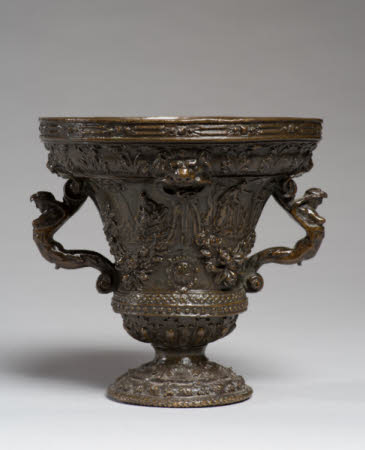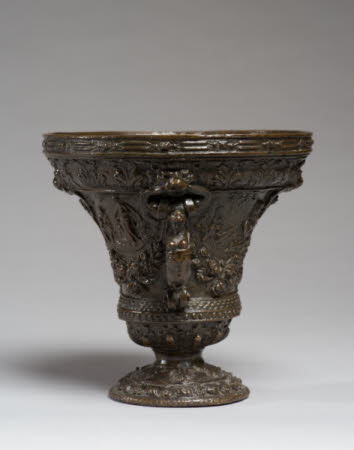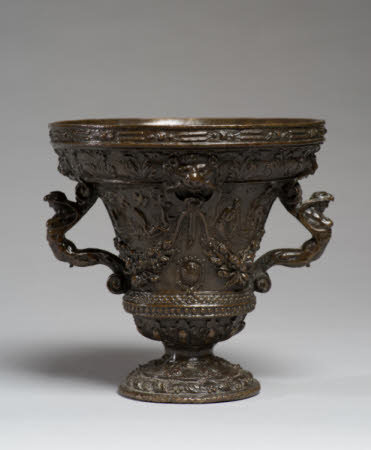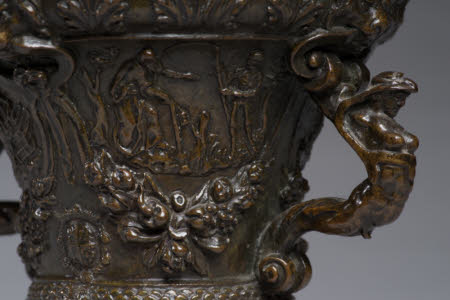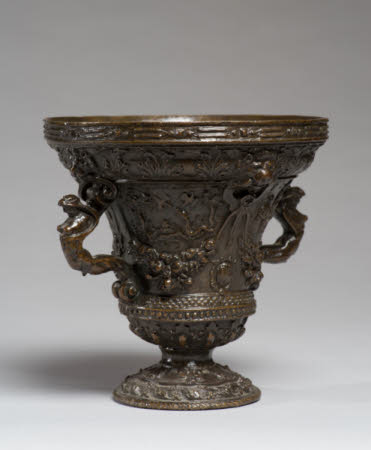Vessel with allegorical scenes and the arms of Alfonso d’Este, Marquess of Montecchio
Alberghetti Foundry
Category
Art / Sculpture
Date
c. 1562 - 1587
Materials
Bronze
Measurements
132 x 137 mm; 131 mm (Diameter); 70 mm (Diameter)
Place of origin
Ferrara
Order this imageCollection
Anglesey Abbey, Cambridgeshire
NT 514973
Summary
Bronze, vessel with allegorical scenes and the arms of Alfonso d’Este, Marquess of Montecchio, Alberghetti Foundry, Italian (probably Ferrarese) School, c. 1562-1587. An urn-shaped two-handled bronze vessel with a flared top made in Ferrara or Venice, c. 1562-87, in the workshop of the Alberghetti family of bronze-casters. The body of the vessel is heavily decorated with relief decoration, including acanthus leaf, swags suspended from lions’ mouths and beading. Above each swag an allegorical scene. On each side, below the lions’ heads, a small embossed cartouche with a coat-of-arms, a five-pointed coronet over a shield with eagle quartered with three fleurs-de-lis, for Alfonso d’Este, marchese di Montecchio (1527-87). Handles are in form of female herms. Underside of base decorated with crude concentric circles. The vessel was probably originally fitted with a cover, which is now lost.
Full description
This elegant and refined vessel appears at first sight to be a mortar, a circular bronze vessel traditionally used for grinding food and pharmaceutical products. However, it cannot be a mortar, since by the nature of their function, the insides of mortars are invariably smoothly finished, whereas the interior of this vessel has been left rough. The inside was clearly not meant to be seen, so it may well be that it was originally equipped with a separately made cover, which is now lost. The surfaces of the vessel are embellished with four allegorical reliefs above heavy swags of fruits and flowers, as well as extensive foliate and other decoration. The iconography of the allegorical reliefs is complex: 1. An elderly scholar at right reclines upon a pile of books, holding a pair of dividers. At left a burning pyre, in the centre a rain storm. 2. An elderly man, bearing a stick and an hour-glass, meets Death bearing a scythe. Between them a tree stump. 3. Two birds mob a serpent, trees at each side. Clouds in the sky. Fallen tree (?) on ground in centre. 4. Naked young man kneels in supplication before a naked woman, another naked man walks away at right. The kneeling man appears to hold the end of a chain, another on the ground, bird (?) in the air. These allegories may be imprese, clever and often highly personal and recondite pictorial devices, often accompanied by a motto, that were popular with educated Renaissance men and women. None of them however appear in any of the standard anthologies published in the sixteenth and seventeenth centuries. Each allegorical scene is framed with a swag of fruit and leaves, and between each of these is a small badge with the Este coat-of-arms, surmounted by a marquess’s crown. The arms would appear to be those of Alfonso d’Este (1527-87), the second of two illegitimate sons that Alfonso I d’Este, Duke of Ferrara (1476-1534) had with his mistress Laura Dianti. In his will of 1533, Duke Alfonso granted his legitimate and illegitimate sons titular lordships, in the case of the young Alfonso the small city of Montecchio, today’s Montecchio Emilia. In 1562 the city was raised to a marquessate by the Holy Roman Emperor Ferdinand I (Angelo Spaggiari and Giuseppe Trenti, Gli Stemmi Estensi ed Austro-Estensi. Profilo Storico, Modena 1985, p. 98, Tav. XII.1). The vessel, with its marquess’s crown, must have been made between 1562 and Alfonso’s death in 1587. The vessel is likely to be the work of the Alberghetti, a family of bronze-casters originally from near Ferrara, who worked in Ferrara, Florence and Venice. The Alberghetti dynasty is especially closely associated with the Venice Arsenal, where members of the family worked as cannon founders from the late fifteenth to the nineteenth century. The vessel appears in the catalogue of the auction sale in 1923 of the collection of the wealthy American banker William Salomon. The catalogue entry records that the bronze had over the previous two decades passed through three collections, those of Louis Huth, Ernest Govett and S.E. Kennedy. However, the sale catalogues for the European works of art from the collections of Huth (Christie’s 1905) and Kennedy (Christie’s 1918) do not in fact include this object. Govett on the other hand does not seem to have had any public auction sale. This means that the provenance history for the vessel before it came into the Salomon collection cannot be verified. Perhaps the vessel was on each occasion sold privately. Although unproveable in the current state of knowledge, the possibility cannot be entirely discounted that the provenance recorded in the Salomon sale catalogue was invented by the dealer Joseph Duveen, who had sold the vessel to William Salomon, in order to increase its marketability. Jeremy Warren 2020
Provenance
Probably in the collection of Louis Huth (1821-1905); probably in the collection of Ernest Govett; probably in the collection of Sydney Ernest Kennedy (1855-1933); purchased by Duveen Brothers; purchased by William Salomon (1852-1919), New York; sold 'Palatial Mansion & Contents Collected by William J. Saloman' American Art Association, 4-7 April 1923, lot 415; purchased by Huttleston Rogers Broughton, 1st Lord Fairhaven (1896-1966); bequeathed to the National Trust by Lord Fairhaven with the house and the rest of the contents.
Credit line
Anglesey Abbey, The Fairhaven Collection (The National Trust)
Makers and roles
Alberghetti Foundry, founder
References
Christie, Manson & Woods 1971: The National Trust, Anglesey Abbey, Cambridge. Inventory: Furniture, Textiles, Porcelain, Bronzes, Sculpture and Garden Ornaments’, 1971, p. 130.
